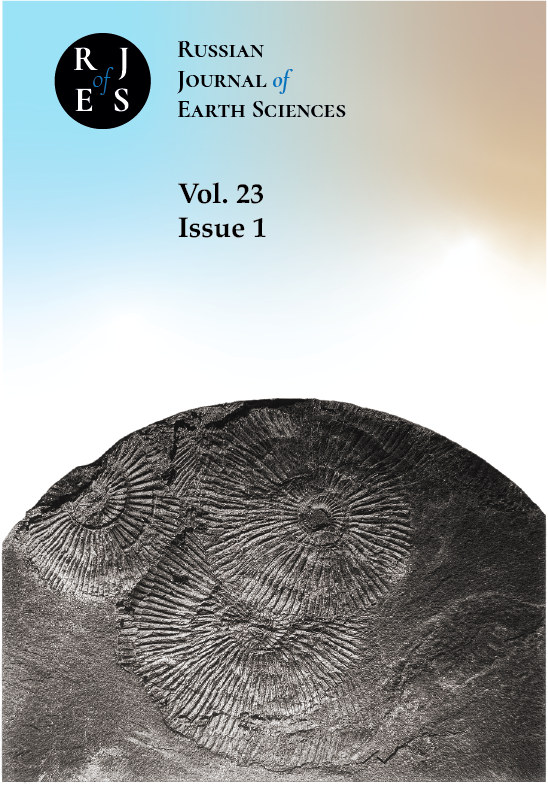Россия
Россия
Россия
Россия
Россия
The first results of data processing of the experiment on the Nizhny Novgorod cable car are presented. A pulsed X-band radar was installed on a technological trolley and performed measurements while moving in two modes that worked sequentially. In the radio altimeter mode, the reflected waveform was measured and the distance to the scattering surface was determined. In the Doppler mode, the Doppler spectrum of the reflected signal was measured, which contains information about the statistical parameters of the surface. Data processing was carried out and the first results confirmed the assumption that the Doppler spectrum can be an effective tool for classifying the type of the underlying surface according to the "ice/water" criterion. Subsequent data processing will allow us to evaluate the accuracy of the developed algorithms.
quasi-specular scattering, nadir sounding, water and ice Doppler spectra, reflected pulse waveform, experiment, x-band radar
1. Brennan, M. J., C. C. Hennon, and R. D. Knabb (2009), The Operational Use of QuikSCAT Ocean Surface Vector Winds at the National Hurricane Center, Weather and Forecasting, 24(3), 621-645, doihttps://doi.org/10.1175/2008waf2222188.1.
2. Elfouhaily, T., D. Vandemark, J. Gourrion, and B. Chapron (1998), Estimation of wind stress using dual-frequency TOPEX/POSEIDON data, 103(11), 25,101-25,108.
3. Fisher, C. M., G. S. Young, N. S. Winstead, and J. D. Haqq-Misra (2008), Comparison of Synthetic Aperture Radar-Derived Wind Speeds with Buoy Wind Speeds along the Mountainous Alaskan Coast, Journal of Applied Meteorology and Climatology, 47(5), 1365- 1376, doihttps://doi.org/10.1175/2007jamc1716.1.
4. Freilich, M. H., and P. G. Challenor (1994), A new approach for determining fully empirical altimeter wind speed model functions, Journal of Geophysical Research, 99(C12), 25,051, doihttps://doi.org/10.1029/94jc01996.
5. Furevik, B., and E. Korsbakken (2000), Comparison of derived wind speed from synthetic aperture radar and scatterometer during the ERS tandem phase, IEEE Transactions on Geoscience and Remote Sensing, 38(2), 1113-1121, doihttps://doi.org/10.1109/36.841990.
6. Horstmann, J., W. Koch, S. Lehner, and R. Tonboe (2000), Wind retrieval over the ocean using synthetic aperture radar with C-band HH polarization, IEEE Transactions on Geoscience and Remote Sensing, 38(5), 2122- 2131, doihttps://doi.org/10.1109/36.868871.
7. Karaev, V., M. Kanevsky, M. Meshkov, and E. Kovalenko (2010), The concept of the advanced space microwave radar for remote sensing of the ocean at small incidence angles, p. 23, National Taiwan Ocean University, Keelung, Taiwan.
8. Karaev, V., M. Panfilova, Y. Titchenko, E. Meshkov, and M. Ryabkova (2018), Experiment at the International Space Station: a microwave radar with scanning fan beam antenna at nadir probing, pp. 232-233, 25 years of Progress in Radar Altimetry symposium, Ponta Delgata, Portugal.
9. Karaev, V., M. Ryabkova, M. Panfilova, Y. Titchenko, E. Meshkov, and E. Zuikova (2021a), Microwave Doppler Radar Experiment on a River, in 2021 IEEE International Geoscience and Remote Sensing Symposium IGARSS, pp. 7350-7353, IEEE, doihttps://doi.org/10.1109/igarss47720.2021.9554820. EDN: https://elibrary.ru/NIIBNK
10. Karaev, V., K. Ponur, M. Panfilova, Y. Titchenko, M. Ryabkova, and E. Meshkov (2022a), Radar Sensing of SEA ICE at the Small Incidence Angles: Simulation and Comparison of the Different Approaches, IGARSS, doihttps://doi.org/10.1109/igarss46834.2022.9883231.
11. Karaev, V., Y. Titchenko, M. Panfilova, M. Ryabkova, E. Meshkov, and K. Ponur (2022b), Application of the Doppler Spectrum of the Backscattering Microwave Signal for Monitoring of Ice Cover: A Theoretical View, Remote Sensing, 14(10), 2331, doihttps://doi.org/10.3390/rs14102331. EDN: https://elibrary.ru/BZCDEZ
12. Karaev, V. Y., M. B. Kanevsky, G. N. Balandina,P. D. Cotton, P. G. Challenor, C. P. Gommenginger, and M. A. Srokosz (2002), On the problem of the near ocean surface wind speed retrieval by radar altimeter: A two-parameter algorithm, International Journal of Remote Sensing, 23(16), 3263-3283, doihttps://doi.org/10.1080/01431160110075587. EDN: https://elibrary.ru/LHIJQN
13. Karaev, V. Y., M. A. Panfilova, M. S. Ryabkova, Y. A. Titchenko, E. M. Meshkov, and X. Li (2021b), Retrieval of the two-dimensional slope field by the SWIM spectrometer of the CFOSAT satellite: discussion of the algorithm, Russian Journal of Earth Sciences, 21(6), 1-9, doihttps://doi.org/10.2205/2021es000784.
14. Lillibridge, J., R. Scharroo, S. Abdalla, and D. Vandemark (2014), Oneand Two-Dimensional Wind Speed Models for Ka-Band Altimetry, Journal of Atmospheric and Oceanic Technology, 31(3), 630-638, doihttps://doi.org/10.1175/jtech-d-13-00167.1.
15. Micran JSC (2022), Research and Production company Micran Joint Stock Company, https://www.micran.com/, Accessed: October 2, 2022.
16. Nekrasov, A., J. Ouellette, N. Majurec, and J. T. Johnson (2013), A Study of Sea Surface Wind Vector Estimation From Near-Nadiral CrossTrack-Scanned Backscatter Data, IEEE Geoscience and Remote Sensing Letters, 10(6), 1503-1506, doihttps://doi.org/10.1109/lgrs.2013.2261047. EDN: https://elibrary.ru/SKXXYL
17. Nekrasov, A., A. Khachaturian, V. Veremyev, and M. Bogachev (2017), Doppler Navigation System with a Non-Stabilized Antenna as a Sea-Surface Wind Sensor, Sensors, 17(6), 1340, doihttps://doi.org/10.3390/s17061340. EDN: https://elibrary.ru/YQHZDT
18. Panfilova, M., V. Karaev, L. Mitnik, Y. Titchenko, M. Ryabkova, and E. Meshkov (2020), Advanced View at the Ocean Surface, Journal of Geophysical Research: Oceans, 125(11), doihttps://doi.org/10.1029/2020jc016531. EDN: https://elibrary.ru/BMEVAI
19. Quilfen, Y., B. Chapron, and D. Vandemark (2001), The ERS Scatterometer Wind Measurement Accuracy: Evidence of Seasonal and Regional Biases, Journal of Atmospheric and Oceanic Technology, 18(10), 1684-1697, doi: 10/dwmrbz.
20. Ricciardulli, L., and F. J. Wentz (2015), A scatterometer geophysical model function for climatequality winds: QuikSCAT ku-2011, Journal of Atmospheric and Oceanic Technology, 32(10), 1829-1846, doihttps://doi.org/10.1175/jtech-d-15-0008.1.
21. Rivas, M. B., A. Stoffelen, and G.-J. van Zadelhoff (2014), The Benefit of HH and VV Polarizations in Retrieving Extreme Wind Speeds for an ASCAT-Type Scatterometer, IEEE Transactions on Geoscience and Remote Sensing, 52(7), 4273-4280, doihttps://doi.org/10.1109/tgrs.2013.2280876.
22. Ryabkova, M., V. Karaev, M. Panfilova, Y. Titchenko, E. Meshkov, and E. Zuikova (2020), Doppler spectrum of backscattered microwave signal: experiment at the river, Sovremennye problemy distantsionnogo zondirovaniya Zemli iz kosmosa, 17(5), 213- 227, doihttps://doi.org/10.21046/2070-7401-2020-17-5-213-227. EDN: https://elibrary.ru/BPFTED
23. Shen, H., W. Perrie, Y. He, and G. Liu (2014), Wind speed retrieval from VH dual-polarization RADARSAT-2 SAR images, IEEE Transactions on Geoscience and Remote Sensing, 52(9), 5820-5826, doihttps://doi.org/10.1109/tgrs.2013.2293143.
24. Stoffelen, A., et al. (2017), Scientific Developments and the EPS-SG scatterometer, IEEE Journal of selected topics in Applied Earth Observations and Remote Sensing, 10(5), 2086-2097, doihttps://doi.org/10.1109/jstars.2017.2696424.
25. Vesti (2022), Radar for a fire aircraft is being developed by specialists from Nizhny Novgorod, Russian news channel, https://vestinn.ru/news/society/1957 32/.
















